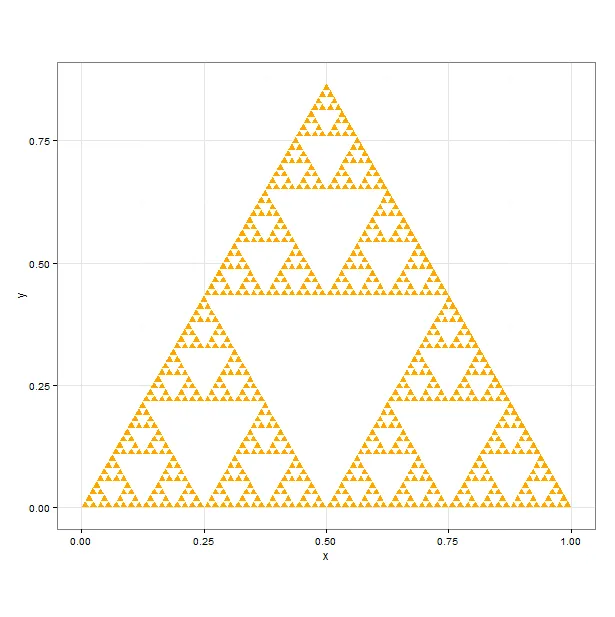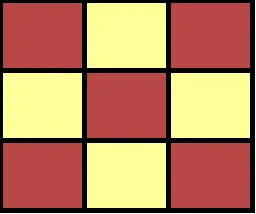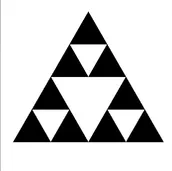geom_raster() 对于形状相等的正方形瓷砖是最快的。
可能你需要使用 geom_polygon() - 这里是 Sierpinski:
记得使用 coord_fixed(ratio=1),否则形状比例会随着查看器的形状而缩放:
编辑 - 抱歉,意识到我没有给你 Sierpinski(不确定我当时在想什么)fixed

require(ggplot2)
require(reshape2)
t.h<-sin(2*pi/6)
sierpinski<-function(iter=3){
n<-2^iter
points<-ldply((n-1):0,function(x){
data.frame(
y=rep(n-x-1,x)*t.h/n,
x=seq((from=(0.5/n)+(n-x)*(0.5/n)),by=1/n,length.out=x)
)
})
points$id<-1:nrow(points)
rbind(
points,
points+matrix(c((t.h/n),(-0.5/n),0),nrow(points),ncol=3,byrow=T),
points+matrix(c((t.h/n),(0.5/n),0),nrow(points),3,byrow=T)
)
}
axiom<-data.frame(x=c(0,0.5,1),y=c(0,t.h,0))
iterations<-6
ggplot() + theme_bw() + coord_fixed(ratio=1) +
geom_polygon(data=axiom,aes(x,y), fill="orange") +
lapply(1:iterations,function(x){
geom_polygon(data=sierpinski(x),aes(x,y,group=id), fill="white")
})
此外,使用这些非常精确的递归和序列模型时,你应该知道:有时ggplot提供的图像可能不完全符合你的期望。例如,如下所示的康托尔尘图:
使用ggplot(使用raster)可以看到,即使输出是高分辨率的,“腿”看起来也不一致,而你在数学上知道它们是一致的。如果你下载图像并缩放,你会看到底部的不一致之处。
在下面的代码中,我展示了如何通过创建一个即时的原始png文件来生成精确的图片。如果你需要精度,请不要害怕这样做!原始图像生成的输出如下:
祝你好运!
n<-9
m<-matrix(sapply(n:1,function(x){
str.zero<-rep(0,3^(x-1))
str.one<-rep(1,3^(x-1))
rep(c(str.one,str.zero),length.out=3^(n-1))
}),nrow=n,byrow=T)
m.cantor<-apply(m,2,cumprod)
ggplot(melt(m.cantor)) + theme_bw() +
geom_raster(aes(x=Var2,y=-Var1,alpha=value),color="white")
require(png)
dim(m.cantor)
new.m<-matrix(sapply(1:n,function(x)rep(m.cantor[x,],700)),nrow=n*700,byrow=T)
dim(new.m)
img.raw<-array(c((1-new.m),
(1-new.m),
(1-new.m),
new.m^0
),
dim=c(dim(new.m),4))
writePNG(img.raw,"cantor.png")
 或
或
 我考虑使用复数来定义点,但仍没有明确的想法如何填充特定区域(例如用两种不同颜色)。
我考虑使用复数来定义点,但仍没有明确的想法如何填充特定区域(例如用两种不同颜色)。 或
或
 我考虑使用复数来定义点,但仍没有明确的想法如何填充特定区域(例如用两种不同颜色)。
我考虑使用复数来定义点,但仍没有明确的想法如何填充特定区域(例如用两种不同颜色)。
